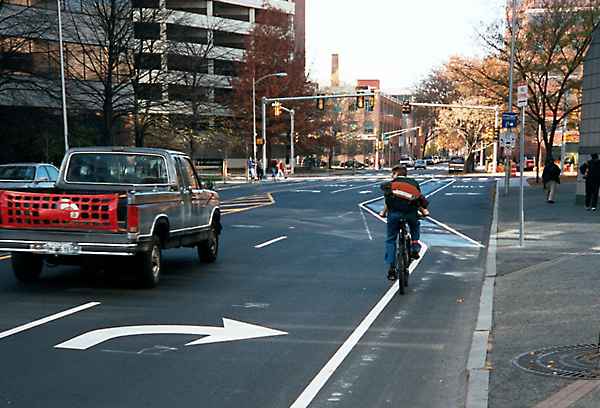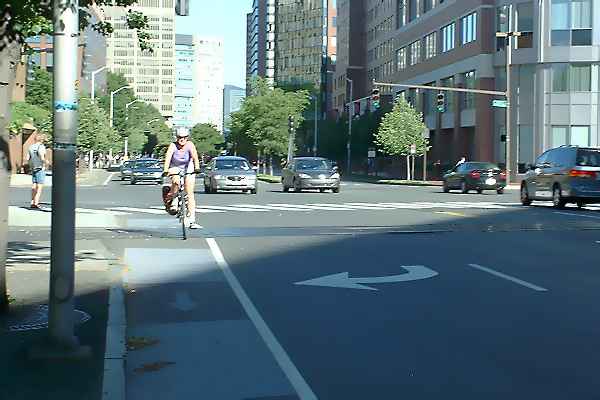
Top: Home Page
Up: Cambridge bicycle facilities and program
Previous:
Next:
Blue lane on Broadway,
|

According to the normal rules of the road, the bicyclist in the photo should yield to traffic in the right-turn lane, or get a driver's cooperation to merge into line, before crossing into the next lane to continue straight through on Broadway. According to these rules, the bicyclist may merge anywhere along the street, except in an intersection, after determining that merging is safe. For information on how bicyclists can negotiate merges across motor traffic, see Chapter 3 of Bicycling Street Smarts, on this Web site. The bicyclist in the photo is looking back over his shoulder to yield to through traffic according to the normal rules. A bicyclist who is unable to merge may continue along the right side of the street and then use the crosswalk as a pedestrian. Some bicyclists may prefer this option, but it is much slower. Except where traffic is very fast and heavy, most bicyclists are capable of a vehicular-style merge. Here, on Broadway, the traffic is never very fast, and it is even slower when it is heavy. The Broadway blue lane installation looks much the same as the standard arrangement for merging: as the bike lane approaches the intersection, it places through-traveling bicyclists to the left of the right-turning traffic. In this way, it differs from numerous other bike lane installations in Cambridge (see example on another page). The impression of normality is deceptive. The blue lane is unlike the normal arrangement, in two ways:
The blue lane installation is deceptive in that it mimics the standard arrangement in which crossing traffic must yield, while overturning that arrangement. A bicyclist may accept the premise of the blue lane and swerve out from the curb along the prescribed route without checking for overtaking traffic. A motorist who assumes that the normal arrangement applies may proceed without yielding. Many motorists who are going to turn right enter this block of Broadway in
the second lane out from the curb, and do not merge right until the blue lane has begun to
angle out from the right curb, increasing the risk to bicyclists who do not look back for traffic. At the June, 2002 meeting of the Cambridge Bicycle Committee, Bicycle/Pedestrian Coordinator Cara Seiderman coyly announced that "something cool" had been added to the blue lane installation, without describing what it was. An inspection of the installation revealed that the "something cool" was the sign at the right, which is also used in blue lane installations in Portland, Oregon. This sign indicates that motorists are to yield to bicyclists, as would be normal when crossing a bike lane to enter a right turn pocket. But the sign doesn't correspond to the actual Cambridge installation, in which the motorists in the right turn-lane are traveling straight and the bicyclists are crossing it from right to left. The photo sequence below was taken July 10, 2002, and the new sign is visible at the right side of the photos. Three motor vehicles are preparing to turn right; the first and third of these arrive from the center lane. Run your mouse cursor over the picture to see the second photo in the sequence. |
Blue lane sign and maneuver.
Pass your mouse cursor over the image
to see what happened a couple of seconds later
The bicyclist did not yield. Fortunately, the two motorists who were behind the bicyclist did yield. Both of these motorists had to brake to avoid the bicyclist. (I moved out into the roadway to take my picture after the bicyclist and the white car had already passed. As is clear from the first picture, the SUV driver was already in the right turn lane and had no need to avoid me; the blue car was in the next lane and slightly behind the SUV when I stepped out). Motorists who enter the block by turning right from the previous cross street must merge across the bike lane and one travel lane to the second travel lane to continue straight at the end of the block. If they do not merge early, they will themselves be following the blue lane as they merge. Motorists who enter the block by traveling straight along Broadway and then want to turn right, must also merge early, so they will cross the blue lane in the right turn lane as intended. As the previous photo shows, this does not always work out. The blue lane therefore reduces the distance available for merging by motorists and bicyclists alike, by requiring motorists to merge early and bicyclists to merge late. The City has attempted to avoid motorists' merging late by painting a right-turn arrow near the beginning of the block, as shown in the photo below. Motorists are most likely to see this marking while in the intersection preceding it, but merging inside an intersection is undesirable (and in most states, against the law) because of the risk of collisions due to misunderstanding about a driver's intentions. The bike lane is carried across the right side of the previous intersection, encouraging motorists to turn right from the left side of bicyclists at the far side of the intersection and bicyclists to keep right until the designated merge location. |

I observed many motorists having to slow and wait for bicyclists to cross in the blue lane when the merges could have been accomplished without delay if there had been no prescribed merging location. The blue lane installation is less efficient in terms of both space and time than a standard installation. I have witnessed an even stranger behavior: a bicyclist followed this blue lane to the left side of the right turn lane and then turned right into Hampshire Street. This bicyclist apparently was under the impression that he ought to use the blue lane regardless of his destination. The confusion is not surprising. The blue lane delineates bicyclists' path very strongly. Bicyclists have to exit the blue lane and cross a solid white line to turn right in the normal way. Though I grant that many bicyclists are uncomfortable about merging on arterial streets, I don't like the blue lane "solution". The assumption underlying the blue lane appears to be that bicyclists can, and should, put all of their trust in motorists to yield in a situation where the motorists normally would not yield. Such blind trust is foolish. To be sure that you can merge safely, whether on a bicycle or in a motor vehicle, you must look back and confirm that you are not getting into anyone's way, or else negotiate with the driver behind you to let you into line. Any adult with normal abilities can do this on a bicycle or in a motor vehicle. Bicyclists who can not do this -- mostly, children -- can cross as pedestrians. But few children ride in any case on this major arterial in an office/industrial district. A solution is to be found in education, along with a less prescriptive, standard facilities design. Another page on this site discusses blue lanes more generally. Thanks to Ken O'Brien, Trevor Bourget, Fred Oswald, Kat Iverson and others, for comments and suggestions. |
| Top: Home Page Up: Cambridge bicycle facilities and program Previous: Next: |
Contents copyright 2002, John S. Allen, |